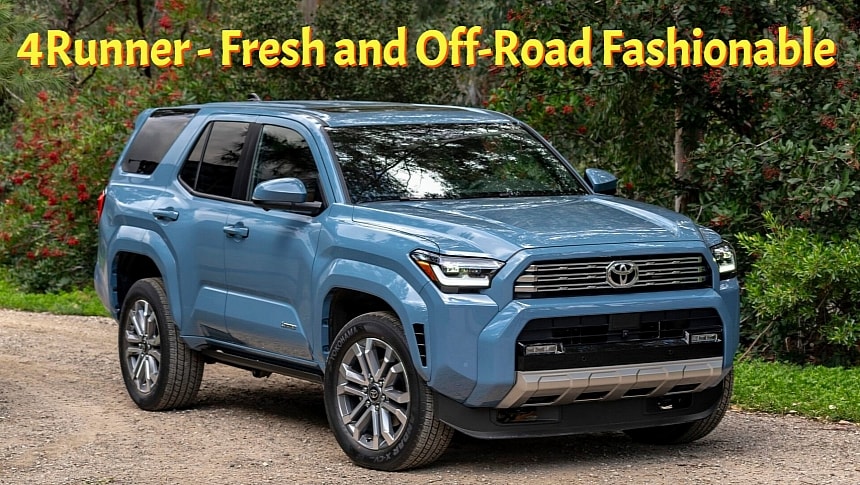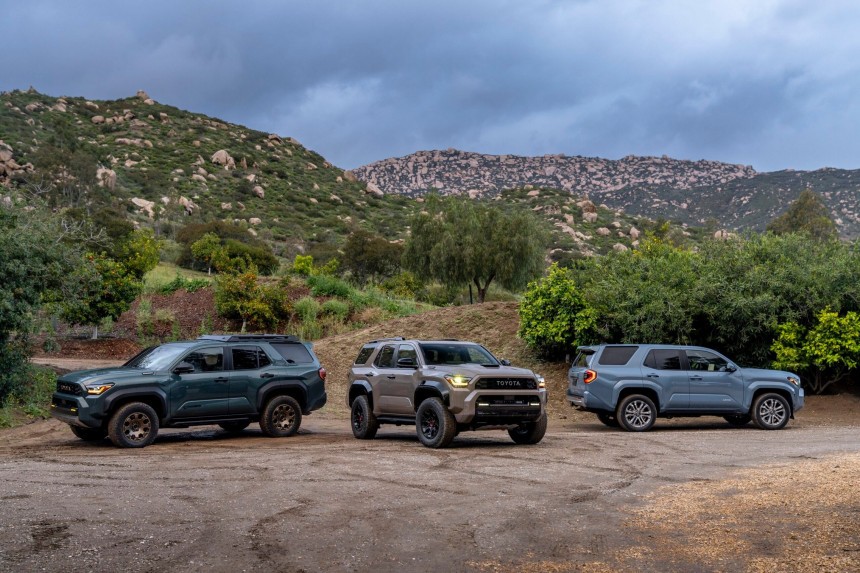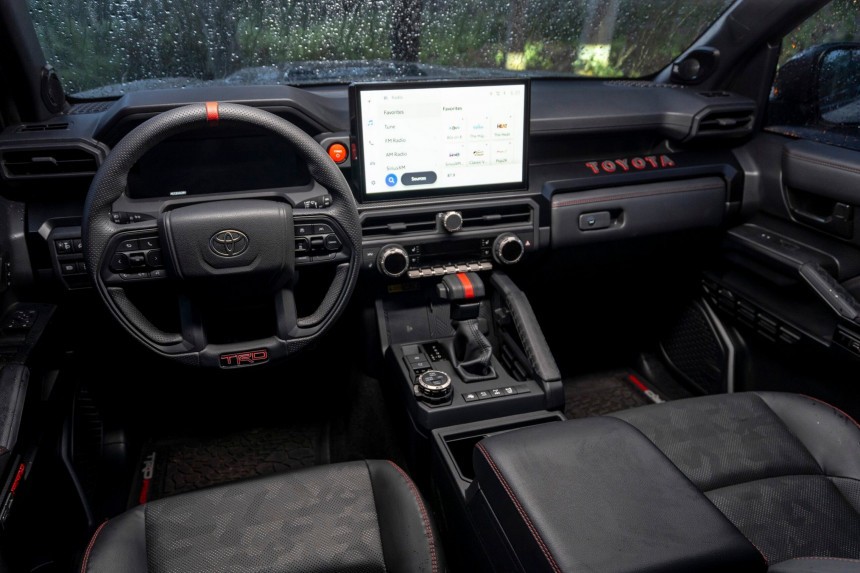The all-new, TNGA-F-based sixth generation 4Runner sure feels already like a match made in off-road SUV heaven between the N400 Tacoma's freshness and the N280's tough 4Runner persona, right?
If we also count the 1981 to 1983 Toyota Trekker predecessor, the compact, then mid-size traditional SUV dubbed by Toyota as 4Runner is a lot older than the Toyota Tacoma compact, then mid-size pickup truck, which was born in 1995. However, the automotive industry doesn't have any problem with the new kid on the block taking the lead when it suits their interests.
As such, the N400 fourth-generation Toyota Tacoma, which was released in 2023, is taking the lead and showing the way forward for the older sixth-generation 2025 Toyota 4Runner that continues to be produced in Japan at the Tahara factory and will arrive in America later this year during the fall season. It won't come alone, though, as it has some great facts, figures, and features to showcase for itself.
First and foremost, the old-school 4Runner is finally switching to a modern platform – the TNGA-F setup shared with the Tacoma, Land Cruiser, Tundra, and Sequoia, which "utilizes a high-strength boxed, steel-ladder frame and features a multi-link coil rear and double-wishbone front suspension." Paired with the i-Force Max powertrain, it will be capable of towing up to 6,000 pounds or 2,722 kg.
Secondly, while produced in Japan, the 4Runner is actually an American design – the Michigan-based CALTY design team "spearheaded" the styling and brought back the legacy "wrap over" quarter glass as a tribute to the first and second generations while also keeping the popular roll-down rear window. There's still an option for three rows of seats, and the second one has tumble seats to "increase 4Runner interior versatility and maximize cargo floor usage."
Thirdly, the all-new Toyota 4Runner ditches the 4.0-liter V6, especially the ultra-obsolete five-speed automatic transmission, in favor of modern inline-four turbo 2.4-liter powertrains. As such, the i-Force version has 278 hp and 317 lb.-ft. of torque plus an eight-speed auto box like on the Tacoma. SR5, TRD Sport, TRD Off-Road, and Limited grades feature it as standard equipment. The i-Force Max, meanwhile, is optional on TRD Off-Road and Limited while standard on the TRD Pro, Trailhunter, and Platinum models with 326 electrified ponies, just like on the Tacoma and 2024 Land Cruiser.
Fourth, rugged capability is at an all-time high to make sure it can fight off the Jeep Wrangler and Ford Bronco. There's a new, optional Stabilizer Bar Disconnect Mechanism, a 32-degree approach, and 24-degree departure angles, an optional Multi-Terrain Monitor system, 2WD (Auto LSD), part-time 4WD, or Full-time 4WD, the latter with an electronically controlled two-speed transfer case with high/low range along with Active Traction Control (A-TRAC) and an automatic limited-slip differential (Auto LSD).
The electronic locking rear differential is standard if you want the TRD Off-Road, TRD Pro, and Trailhunter grades. Meanwhile, the Limited (optional) and Platinum (standard) trims feature a full-time four-wheel-drive system with a center-locking differential on i-Force Max models. The Multi-Terrain Select system works both with 4WD-High and 4WD-Low, plus the new, quieter CRAWL Control function and Downhill Assist Control also help the driver in off-road scenarios.
Fifth, there's a grade for everyone, according to Toyota. More precisely, there are nine of them! SR5, TRD Sport, TRD Sport Premium, TRD Off Road, TRD Off Road Premium, Limited, Platinum, TRD Pro, and Trailhunter. The latter features Toyota's collaboration with aftermarket companies to include ARB's Old Man Emu (OME) 2.5-inch forged shocks with rear external piggyback remote reservoirs, a bespoke co-designed ARB roof rack, 33-inch Toyo Open Country A/T tires, a standard low-profile high-mount air intake, RIGID LED fog lamps, and more. Also new is the Platinum grade with black details, plus heated second-row seats, a standard tow tech package, a Head-Up Display, and automatic wipers, among others.
Sixth, inside, there's a new standard 8-inch or optional 14-inch central touchscreen for Toyota's latest Audio Multimedia system, designed and engineered by the company's Texas-based Connected Technologies with wireless Apple CarPlay and Android Auto compatibility, Qi wireless charging pad, and five USB-C ports. The standard instrument cluster has a 7-inch screen, while higher grades pack directly the 12.3-inch digital gauge setup. There's also a standard Smart Key System with a push-button start plus an optional Digital Key with an active Remote Connect trial or subscription account.
Seventh, the "youthful and dynamic" 4Runner rounds up Toyota's tough body-on-frame vehicle lineup that runs through the Tacoma, Land Cruiser, Sequoia, and Tundra models. Plus, all 2025MY 4Runner models come standard with Toyota Safety Sense 3.0, which also includes the fresh Proactive Driving Assist. The PDA system "uses the vehicle's camera and radar, when system operating conditions are met, to provide gentle braking and/or steering to support driving tasks such as distance control between your vehicle and a preceding vehicle, pedestrian, or bicyclist. PDA can also provide gentle braking into curves."
Other enhancements include the more capable Pre-Collision System with Pedestrian Detection, Lane Departure Alert now with Steering Assist, as well as enhanced lane recognition "that includes detection of certain 3D objects, like guardrails, that may be used to help define the lane." Also, the Dynamic Radar Cruise Control has Full-Speed Range capability and adds a fourth following distance setting. There's also a Lane Tracing Assist function of the DRCC, and the former now integrates an Emergency Driving Stop System. Other functions not part of TSS 3.0 are the Blind Spot Monitor (BSM), Rear Cross-Traffic Alert (RCTA), and the standard Hill Start Assist Control (HAC).
As such, the N400 fourth-generation Toyota Tacoma, which was released in 2023, is taking the lead and showing the way forward for the older sixth-generation 2025 Toyota 4Runner that continues to be produced in Japan at the Tahara factory and will arrive in America later this year during the fall season. It won't come alone, though, as it has some great facts, figures, and features to showcase for itself.
First and foremost, the old-school 4Runner is finally switching to a modern platform – the TNGA-F setup shared with the Tacoma, Land Cruiser, Tundra, and Sequoia, which "utilizes a high-strength boxed, steel-ladder frame and features a multi-link coil rear and double-wishbone front suspension." Paired with the i-Force Max powertrain, it will be capable of towing up to 6,000 pounds or 2,722 kg.
Secondly, while produced in Japan, the 4Runner is actually an American design – the Michigan-based CALTY design team "spearheaded" the styling and brought back the legacy "wrap over" quarter glass as a tribute to the first and second generations while also keeping the popular roll-down rear window. There's still an option for three rows of seats, and the second one has tumble seats to "increase 4Runner interior versatility and maximize cargo floor usage."
Fourth, rugged capability is at an all-time high to make sure it can fight off the Jeep Wrangler and Ford Bronco. There's a new, optional Stabilizer Bar Disconnect Mechanism, a 32-degree approach, and 24-degree departure angles, an optional Multi-Terrain Monitor system, 2WD (Auto LSD), part-time 4WD, or Full-time 4WD, the latter with an electronically controlled two-speed transfer case with high/low range along with Active Traction Control (A-TRAC) and an automatic limited-slip differential (Auto LSD).
The electronic locking rear differential is standard if you want the TRD Off-Road, TRD Pro, and Trailhunter grades. Meanwhile, the Limited (optional) and Platinum (standard) trims feature a full-time four-wheel-drive system with a center-locking differential on i-Force Max models. The Multi-Terrain Select system works both with 4WD-High and 4WD-Low, plus the new, quieter CRAWL Control function and Downhill Assist Control also help the driver in off-road scenarios.
Sixth, inside, there's a new standard 8-inch or optional 14-inch central touchscreen for Toyota's latest Audio Multimedia system, designed and engineered by the company's Texas-based Connected Technologies with wireless Apple CarPlay and Android Auto compatibility, Qi wireless charging pad, and five USB-C ports. The standard instrument cluster has a 7-inch screen, while higher grades pack directly the 12.3-inch digital gauge setup. There's also a standard Smart Key System with a push-button start plus an optional Digital Key with an active Remote Connect trial or subscription account.
Seventh, the "youthful and dynamic" 4Runner rounds up Toyota's tough body-on-frame vehicle lineup that runs through the Tacoma, Land Cruiser, Sequoia, and Tundra models. Plus, all 2025MY 4Runner models come standard with Toyota Safety Sense 3.0, which also includes the fresh Proactive Driving Assist. The PDA system "uses the vehicle's camera and radar, when system operating conditions are met, to provide gentle braking and/or steering to support driving tasks such as distance control between your vehicle and a preceding vehicle, pedestrian, or bicyclist. PDA can also provide gentle braking into curves."
Other enhancements include the more capable Pre-Collision System with Pedestrian Detection, Lane Departure Alert now with Steering Assist, as well as enhanced lane recognition "that includes detection of certain 3D objects, like guardrails, that may be used to help define the lane." Also, the Dynamic Radar Cruise Control has Full-Speed Range capability and adds a fourth following distance setting. There's also a Lane Tracing Assist function of the DRCC, and the former now integrates an Emergency Driving Stop System. Other functions not part of TSS 3.0 are the Blind Spot Monitor (BSM), Rear Cross-Traffic Alert (RCTA), and the standard Hill Start Assist Control (HAC).

























